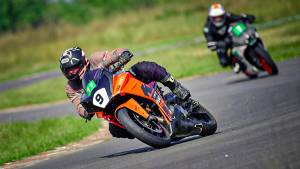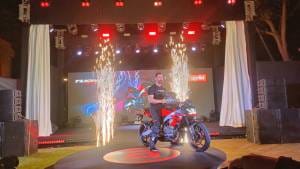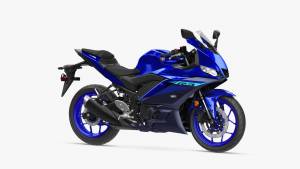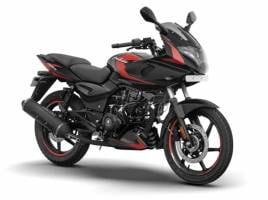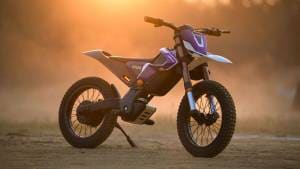2014 KTM RC 390 India road test review
Road tests are best kept to known roads. That allows you to control the variables and have muscle-memory'd benchmarks of effort, response and various other nuances of motorcycles. The stuff that we like to dig through in road tests.
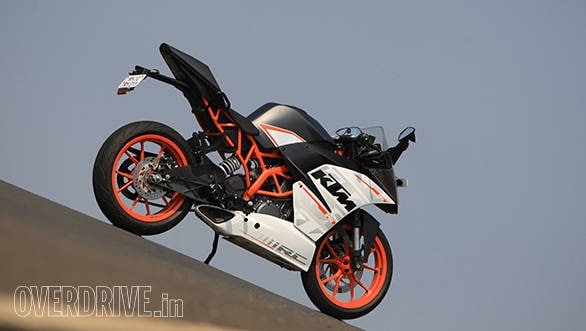
So when I got the chance to ride the KTM RC 390 in India, I decided to hit one of my favourites. An old busy highway that's been replaced by a wider, shinier one and is mostly ignored. It could almost be metaphor for the motorcycle, no? Could the RC 390 have made the Duke 390 redundant? I snip that thought at the root because I know Halley and Rishaad are working on that and I shouldn't go there mentally. We've an RC 390 to test after all. Let's begin.
Design, build and finish
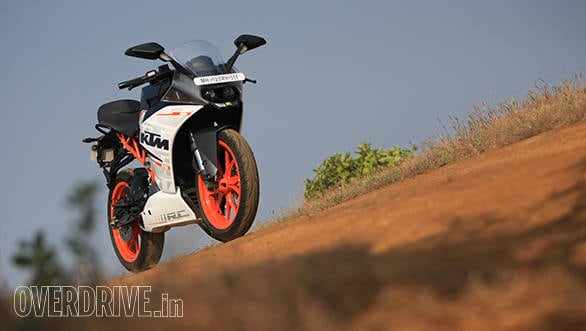 Shumi as usual wants white wheels but the RC 390 looks nice with the white fairing sides. The RC 200's darker scheme though, is more subtle overall
Shumi as usual wants white wheels but the RC 390 looks nice with the white fairing sides. The RC 200's darker scheme though, is more subtle overall
The hot flashes of the first rides are still fresh so there's not much needed by way of describing the design of the RC, right?
To me the standout features are quite obvious. The tailpiece, a piece of matte black PVC foam that's bolted to the higher new subframe is a piece of art. It makes the sportsbike look complete by resembling a single-seater and yet, it's soft foam so it can actually function as a pillion seat. Of course, sportsbike pillion seats are more for the show than for the go so whether the seat actually seats is actually beside the point.
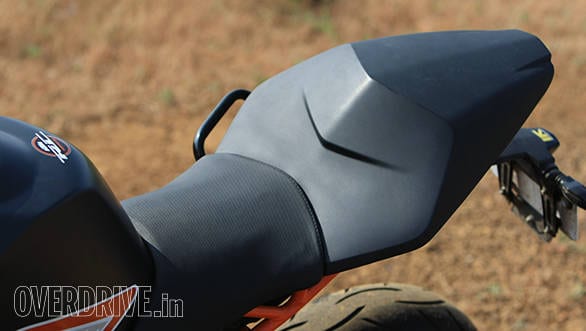 The pillion seat is very cool. The black PVC foam looks exactly like a matte plastic single seat conversion would and it makes the RC immeasurably cool. Wish the rider's seat was quite as good though. The little metal thing you see sticking out is a short handhold so you can walk the bike around. Remove it, we say
The pillion seat is very cool. The black PVC foam looks exactly like a matte plastic single seat conversion would and it makes the RC immeasurably cool. Wish the rider's seat was quite as good though. The little metal thing you see sticking out is a short handhold so you can walk the bike around. Remove it, we say
I also really like the new face. The two projectors placed next to each other and housed in that sharp fairing look very purposeful without allowing too much anthropomorphising in the sense of happy face or purposeful face. I'm also a fan of the clear plastic top fairing as an idea though we will return to it later and see it in a not so positive light.
Finally, I rather like the indicators in the mirror stalks and the short bit at the back with the lights. I suspect it'll all come off easily so that the RC 390 can be turned into a stripped down race bike very quickly. And then back to a streetbike just as fast.
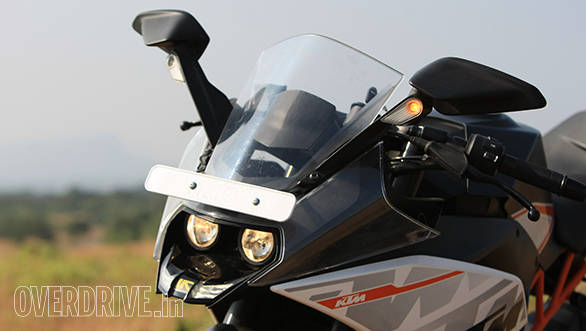 We like the new face that seems to have a purposeful look. The clear upper fairing though is something we like but it's going to make cleaning the RC very complex. Note the see-through bit right above the number plate. There's a little tray there formed by the triangulated fairing support. Please don't use that to keep a dirt rag there. That's a request
We like the new face that seems to have a purposeful look. The clear upper fairing though is something we like but it's going to make cleaning the RC very complex. Note the see-through bit right above the number plate. There's a little tray there formed by the triangulated fairing support. Please don't use that to keep a dirt rag there. That's a request
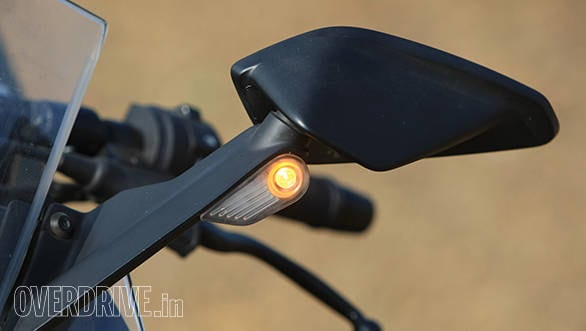 The wee indicators on the mirror stalks are an elegant solution and make the bike sides much cleaner. Mirror adjustability is less overall than the Duke but they're solid in terms of the view behind
The wee indicators on the mirror stalks are an elegant solution and make the bike sides much cleaner. Mirror adjustability is less overall than the Duke but they're solid in terms of the view behind
Build quality is pretty solid as we've seen on the 390 Duke and despite the significantly increased amount of plastic, I suspect the RC 390 will remain a largely clatter free motorcycles. Both Halley and Rohit's RCs did develop an initial clatter - I understand that was fixed at first service but it has returned.
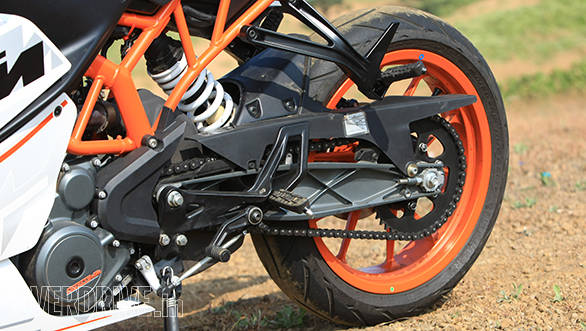 The wheelbase has reduced by 27mm thanks to the sharper front geometry but the swingarm etc are the same as the Duke. Take note of the new heel plates. Unlike on the Duke, these do work and the quality looks good too
The wheelbase has reduced by 27mm thanks to the sharper front geometry but the swingarm etc are the same as the Duke. Take note of the new heel plates. Unlike on the Duke, these do work and the quality looks good too
I do think the finish levels can be improved, though this is a design issue rather than an oversight. There are places where the inverted nature of the black plastic is not fully covering the clear bits. At these places, the RC's fairing looks like it has some sort of a piece missing. The satin black finish largely hides these places (like the leading edges of the tank) but a lighter colour will quickly draw your eyes to them. These bits are particularly jarring because when you consider that these are part of the same motorcycle that features such a precise meeting of the fairing plastic and the exhaust tip.
As an owner, there's little to complain about but as an aesthete or someone with an eye for detail, the KTM RC 390 is a curious mix of the precise and the apparently half-formed.
 The integration of the exhaust tip into the bottom of the fairing is extremely well executed. KTM have promised that the heat will not eventually discolour the plastic
The integration of the exhaust tip into the bottom of the fairing is extremely well executed. KTM have promised that the heat will not eventually discolour the plastic
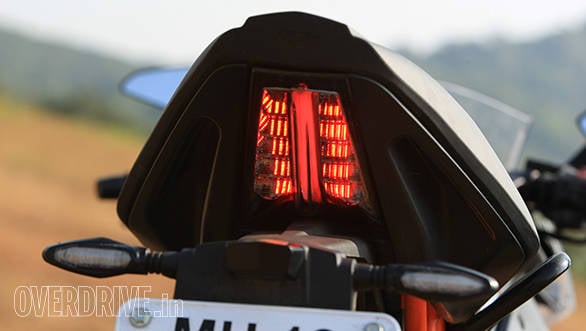 Neatly integrated tail lamps use a thin central Led line as a running tail lamp. Two brighter LEDs flank this line to make a distinctive tail lamp. The countersunk handholds are beside the tail lamp on either side
Neatly integrated tail lamps use a thin central Led line as a running tail lamp. Two brighter LEDs flank this line to make a distinctive tail lamp. The countersunk handholds are beside the tail lamp on either side
[caption id="" align="aligncenter" width="586"]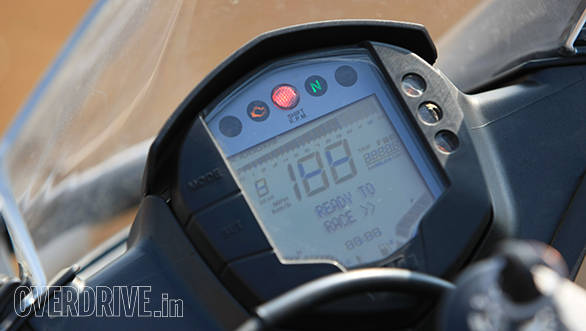 The instruments are the same as the 390 Duke in every single way. The screen is set into the plastic of the fairing. While comprehensive in the information it shows, the smaller details, especially the tacho needs some time to get used to[/caption]
The instruments are the same as the 390 Duke in every single way. The screen is set into the plastic of the fairing. While comprehensive in the information it shows, the smaller details, especially the tacho needs some time to get used to[/caption]
Engine, performance and economy
The powertrain is perhaps the most familiar part of the motorcycle so I will rush through it. Apart from changes in the intake routing, the 373.2cc engine is absolutely identical to the Duke's. It makes the same 43.5PS at the same 9,000rpm and the torque flows down the same path to the rear wheel through the same unchanged gearbox and gearing. It just has to carry an additional 12kg around and at higher speeds, has the advantage of a more slippery shape to pierce the air with.
So it is not unexpected that the RC sounds more or less like the Duke. On the motorcycle, the fairing muffles the sound of the engine and that makes the motorcycle sound quieter and less harsh. This, I like. On the flip side, the fairing also seems to direct the sound of the running fan straight up at you so on a quieter, slower ride through traffic, it will sound like you're riding a high speed fan.
In performance terms, we weren't expecting too much of a difference between the 390 Duke and this motorcycle and there isn't. Initial acceleration favours neither motorcycle but once the wind resistance kicks in, the RC 390 is quicker. Sustained high speeds will be easier on the RC but that's a matter of being behind the fairing rather than actual powertrain benefits accruing.
Ridden hard, the engine is different in feel though. Perhaps it's just the weight or just a slight difference in the throttle spring or cam, but the RC 390 feels calmer and more precise to use than the Duke. Good, smooth throttle work produces direct and measured responses and in that sense, the RC 390 feels like it wants precision a lot more than the Duke.
The gearbox, similarly, is light and precise and the new levers should be less prone to snapping in half in slow speed tipovers. If you thought the boot-lever purchase area was skimpy on the Duke, though, the RC doesn't add more lever room. Personally, this has never been an issue, but then I've never ridden any of these bikes in normal shoes, sneakers, chappals and what have you. And I'm not inclined to either.
Economy reflects the advantage of having a fairing and the RC is marginally more efficient than the Duke on the highway but a little less efficient in town. Overall figures are close enough not to make a difference.
Ride, handling and braking
This is the juicy part of the test. In essence, the Duke and the RC share the main body of the trellis frame but wear visibly different rear subframes. The RC's kicks up higher and is a smidgen longer in length. But the big change is up front, where the RC tucks the front wheel in a bit and has a sharper steering angle. This has the knock-on effort of raising the centre of gravity, cutting the trail and wheelbase down by 27mm apiece. These sound like minor changes but when combined with a front fork that has less travel and is setup stiffer and fake clip-on bars that not only offer less leverage but are also closer to the axle, you have a dramatically different machine on your hands.
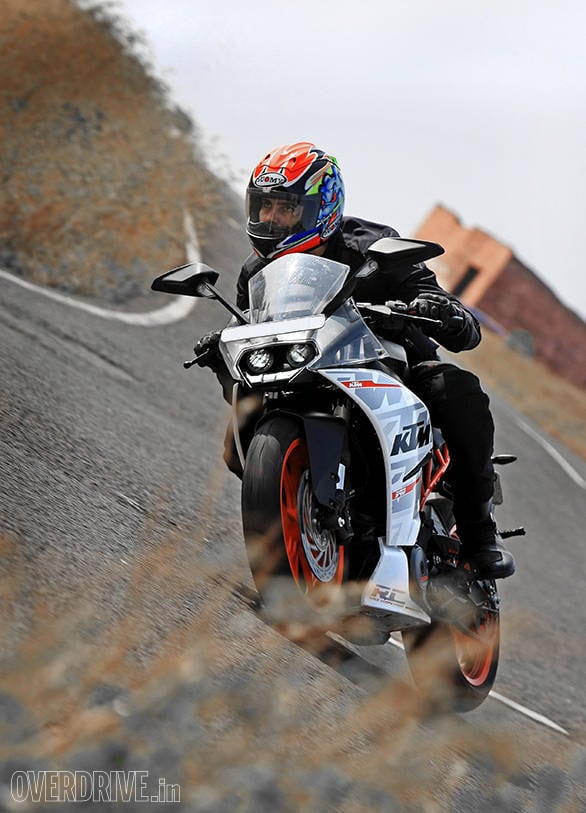 The RC actually steers slower than the Duke and ends up feeling more natural and precise as a result of it. Narrower bars require more effort but switch from the RC to the Duke and you'll feel the loss of accuracy until you recalibrate
The RC actually steers slower than the Duke and ends up feeling more natural and precise as a result of it. Narrower bars require more effort but switch from the RC to the Duke and you'll feel the loss of accuracy until you recalibrate
Where the Duke is all instant response and general hooning about, the RC 390 is much, much calmer in disposition and much harder to unsettle. It steers slower than the Duke and ends up feeling more natural to use after you get past the jump in steering effort that the narrower bars require.
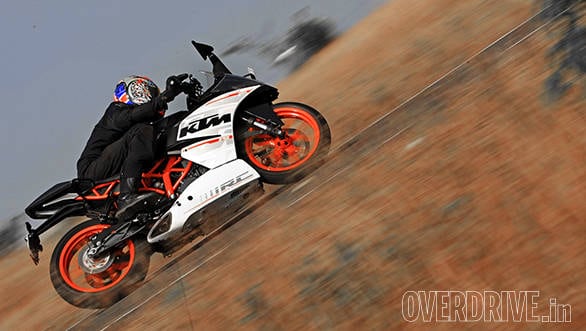 Cornering the RC is what it's all about. The way you feel connected to the motorcycle, in control of the chassis and that sense of hook up and grip is what makes the RC such a special motorcycle to ride. So confident is the chassis that despite great clearance and poise, grinding pegs is easy and once the peg feelers are done, then the boxy bottom of the fairing will also meet tarmac at max lean
Cornering the RC is what it's all about. The way you feel connected to the motorcycle, in control of the chassis and that sense of hook up and grip is what makes the RC such a special motorcycle to ride. So confident is the chassis that despite great clearance and poise, grinding pegs is easy and once the peg feelers are done, then the boxy bottom of the fairing will also meet tarmac at max lean
The higher centre of gravity allows the motorcycle to go from vertical to leaned over till the squared off bottom of the fairing grinds down in a flash. But like the steering, this movement happens quickly while feeling completely natural. It's as if the ability has been retained but the intensity and franticity (there's a word I can call my own) have been dialed back.
What that means is that the RC 390 really sparkles when the hand making the steering and throttle inputs is calm and measured. It doesn't offer the instant gratification that the looser, angrier Duke offers but in mature hands, there's an even tempered precision and quick reflexes that are extremely rewarding to use.
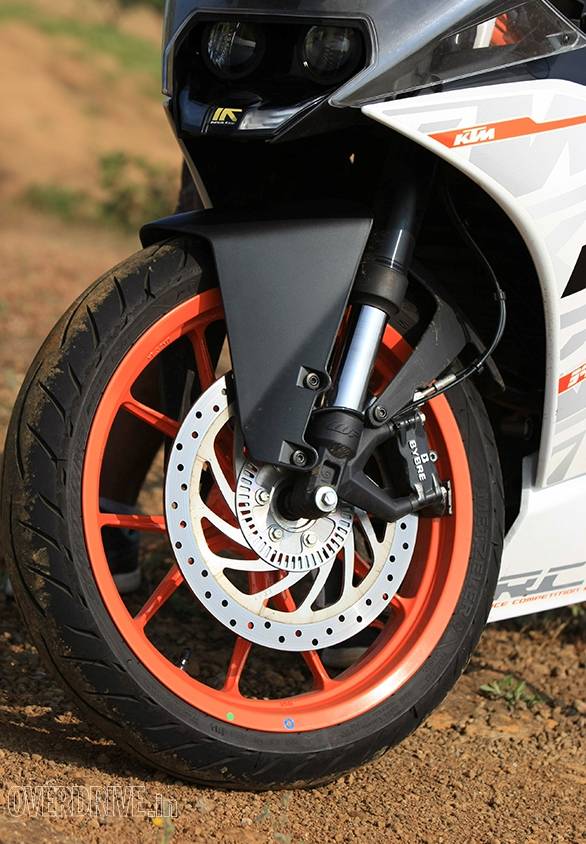 The wheels, tyres and brakes are identical to the Duke 390. But the upside down forks offer less travel and have slightly stiffer damping. The result is great feedback but a more difficult time over bad roads compared to the Duke
The wheels, tyres and brakes are identical to the Duke 390. But the upside down forks offer less travel and have slightly stiffer damping. The result is great feedback but a more difficult time over bad roads compared to the Duke
Naturally, the short travel up front and the stiffer damping means ride quality suffers and while the RC 390 is far, far from the hardest setup we have tested, the Duke is clearly better equipped to hammer past bad roads than the RC.
Braking, again, is better on the RC. The RC's more connected feel makes it easier to get hard-hard-hard on the brakes with full confidence knowing that the excellent ABS system will kick in if your sense of traction doesn't quite coincide with the real world. That said, I would still like KTM to offer more initial bike and a more aggressive ramp up of brake force. There's no lack of brake power right now, but it doesn't feel turned up to 11 like the rest of the motorcycle.
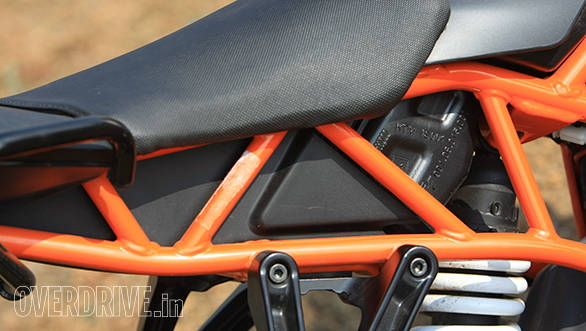 The new rear subframe looks great and rises higher and is marginally longer than the Duke's. It allows KTM to move the rider back and higher which ends up making the RC a much more spacious bike than the Duke is
The new rear subframe looks great and rises higher and is marginally longer than the Duke's. It allows KTM to move the rider back and higher which ends up making the RC a much more spacious bike than the Duke is
But forget the specifics for a moment. The biggest advantage of riding the RC is the amount of feedback it gives you and how plugged in you feel. Whether it's the sensation of the rear hooking up or the front-end digging in as you turn in, that sense of what's going on is wonderful to access and it allows you to use the capable chassis and marvellous Metzeler tyres for hard cornering with great confidence. In that sense, if I were considering buying an RC, it would be for this feel and the cornering capability rather than any other single aspect of the motorcycle.
Features, useability and ownership
Like the 390 Duke, the RC 390 has a reasonably good spread of features. I've come to like the all-digital orange-lit clocks. People have noted that the digital tacho is hard to read. In my experience, you get used to it and can eventually see it flashing across the top of the screen without effort. Bigger would be better, but the tacho works. The RC has some storage space under the rider's seat but it isn't significant. And that's it.
In useability, the RC 390 clearly has issues. The seat for one is hard and badly shaped. On the Duke, we've come to accept an interminably long acclimatisation followed by an equally long span where the hard, flat seat feels near-perfect. On the RC, the curved top of the seat will quickly reduce your backside to tears. I was expecting the forward and low bars (well, relatively speaking) to define how long you could ride the bike. Turns out, your wrists have a far easier time than your behind.
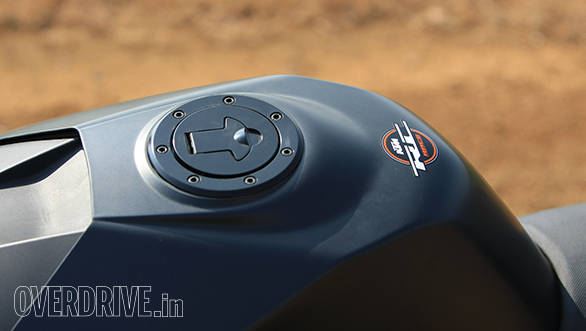 The top of the tank is tiny so beware of putting your helmet on it. The plate on the extreme left is actually a battery cover - part of the new packaging the RC needed to accommodate the new ergonomics
The top of the tank is tiny so beware of putting your helmet on it. The plate on the extreme left is actually a battery cover - part of the new packaging the RC needed to accommodate the new ergonomics
The other issue is minor, but you should pay attention. Between the shape of the seat, tank top and pillion seat, there is almost no space to securely keep a helmet on the bike. My default solution is to put the Shoei on the ground, but I've seen the looks that it get so I know it isn't a universal solution. I'm not a fan of mirror hanging. As in, be careful, else, like Rishaad, you'll be chasing your lid as it rolls around in a petrol pump forecourt.
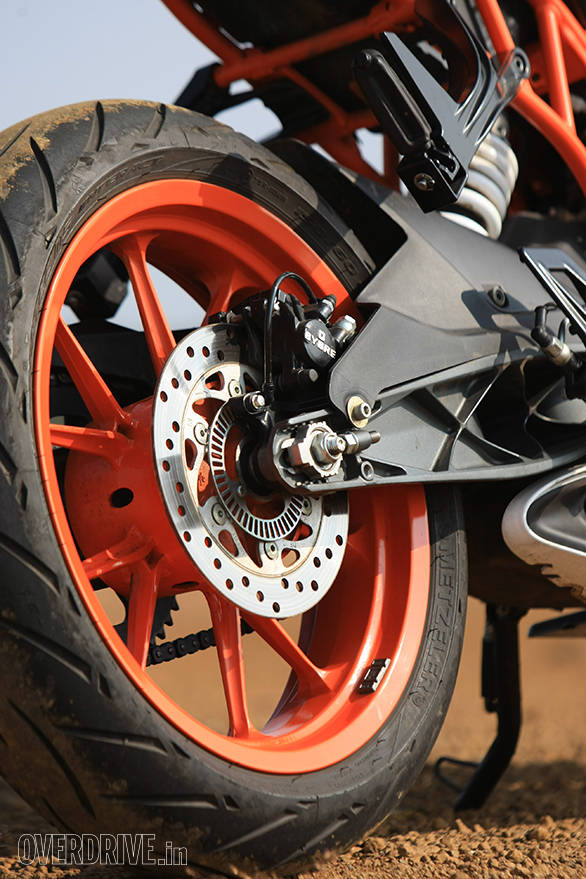 The wheels, brakes and hardware is the same the as 390 Duke on the RC 390. But note the new subframe, new footpeg hanger and pegs as well as the more comprehensive new hugger
The wheels, brakes and hardware is the same the as 390 Duke on the RC 390. But note the new subframe, new footpeg hanger and pegs as well as the more comprehensive new hugger
Finally, I already know the extruded swingarm's bracing makes it hard to keep clean. But the clear plastic form on top of the dark plastic fairing is another cleaning headache. It's hard to reach between the two surfaces for a full-on clean and the RC will consume time on Sundays to clean to Parsi-spec. The solution, an Austrian chap said, was pressure wash. But as you can imagine, that's hardly something you would do daily.
Verdict
The KTM RC 390 is a stunning achievement. Its turn of speed and the lovely feel and precision of the chassis are both new benchmarks for our market. Especially when you factor in the price. The KTM RC 390 is priced at `2.34 lakh on-road Mumbai which makes it `25,000 more than the 390 Duke.
Should you buy one? Oh absolutely. The extra money, if you just account for the extra plastic and powerful headlamps alone, makes this a good deal. But I think it is more important that you understand what you're buying.
The Duke 390, its nearest competitor, is an axe. You can swing it lustily and it'll do loads of damage and as long as you've got wood, it's full entertainment. The RC 390 is more of a scalpel. It's much sharper to use but requires a more measured hand to deliver an outsized reward.
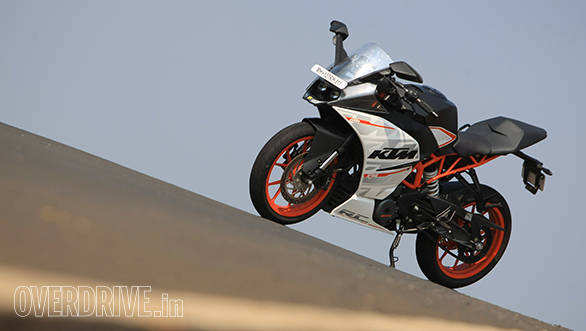
At just Rs 25,000-odd over the Duke, the RC 390 certainly is extremely good value. But unlike the Duke, it has a more specific set of skills and therefore will appeal to a more defined kind of rider
The only exception to this balancing are people who've always dreamt of buying and owning a sportsbike. If that's you, there's nothing more to think about. The engine's been around for ages and it should be reliable. The power will keep you laughing for years and the quality of the motorcycle is pretty good too. You wanted a sportsbike? Here's the best one on the market right now, all things considered.
KTM RC 390 road test
| KTM RC 390 | |
| DRIVETRIAN | |
| Type | Liquid cooled single cylinder |
| Valvetrain | 4 valves/cylinder |
| Displacement | 373.2cc |
| Max power | 43.5PS@9,000rpm |
| Max torque | 35Nm@7,000rpm |
| Power to weight | 262PS/tonne |
| Gearbox | 6-speed |
| SUSPENSION | |
| Front/Rear | Upside down forks/Preload adjustable monoshock |
| BRAKES | |
| Front/Rear | 300mm disc/230mm disc |
| WHEELS & TYRES | |
| Tyre (F/R) | 110/70-R17 / 150/60-R17 |
| GENERAL DATA | |
| Kerb weight | 166kg |
| Wheelbase (mm) | 1340mm |
| PERFORMANCE | |
| 0-100kmph | 5.73s |
| 0-400m | 14.49s/145.63kmph |
| Top speed | 167kmph |
| EFFICIENCY | |
| City | 25.5kmpl |
| Highway | 34.1kmpl |
| Overall | 27.6kmpl |
| PRICE: | Rs 2.34 lakh on-road Mumbai |
More from OVERDRIVE on the KTM RC twins:
KTM RC 390 first ride on track
KTM RC 390 and RC 200 launched in India at Rs 2.05 lakh and Rs 1.60 lakh
KTM RC 200 and 390 Mumbai on-road prices out, three month waiting period
Starts Rs 3,14,000
373cc
6-Speed
43.50
35.00
-NA-
